Learning Avionics’ Differences
by Michael J. “Mick” Kaufman
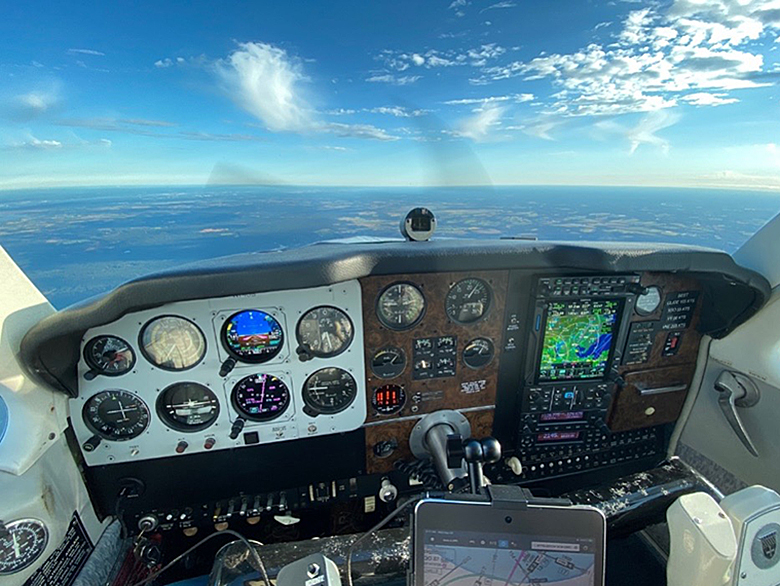
Typical A-36 panel with GI-275 Garmin GNS-750 and GFC-500 autopilot
My position with the BPT flight training program is program manager/flight operations, which I have done for nearly 20 years. In this position, I am responsible for flight scheduling and making sure that all participants have a good experience, while they improve their flying skills, and, hopefully, learn something new.
I always like to fly at the clinics, if possible, but I opt to let the other instructors fly first. At our recent flight clinic in Norfolk, VA, an instructor became ill at the last moment, so I ended up picking up two of the participants he was scheduled to fly with.
My main source of income for the past thirty years has been conducting advanced flight training, specializing in the instrument rating. I have been able to stay current, averaging more than five hundred flight hours yearly. With so many new pieces of avionics on the market, together with mixing and matching, I often see a combination of equipment never seen before, even with the amount of flying I do.
I always take pride in helping pilots learn new things. In fact, it is my job with the BPT to see that every pilot who trains with us is satisfied. After flying with one of my pilots on Saturday afternoon at the last flight clinic, neither the pilot nor I were satisfied or felt we had accomplished anything. In fact, we were discouraged.
This pilot had recently installed a new state-of-the-art avionics panel, and we could not get it to do what we wanted, or what I expected it to do. I had just finished an instrument rating in a Bonanza with a GFC-500 autopilot and a G-500-Txi glass panel driven by two GTN-650 navigators. Congratulations to Alan Sherwood of Richland Center, Wisconsin on getting his instrument rating.
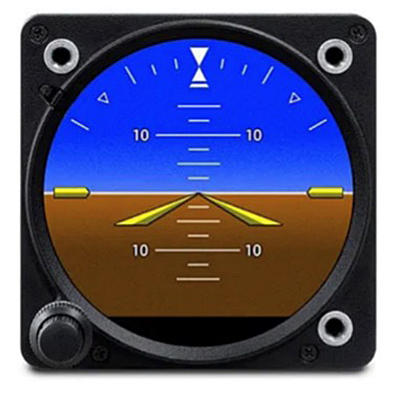
Garmin GI-275 showing basic flight director attitude indicator
The pilot at the Norfolk clinic had the same autopilot GFC-500 but had two GI-275s and nothing worked the same. So, to make this article worth reading, I will be comparing several pieces of Garmin equipment and how they behaved in several different airplanes. I want to point out that what I describe may or may not be a correct install on the part of the avionics shop. I say this because I may not have seen the exact same combinations in more than one aircraft.
Some of the old legacy equipment I have seen time and time together, such as a Garmin GTN 430/530 paired with a King KFC-200 autopilot or S-Tec 55X autopilot. I know what to expect or should expect if it was installed properly.
Having recently spent about forty hours teaching Alan for his instrument rating in a Bonanza with a Garmin GFC-500 autopilot, two Garmin GTN-650 Navigators and a G-500 TXI navigator, I became quite familiar with completing different tasks. Early on in legacy navigators, I found that switching from the GPS mode to VOR/LOC mode was quite friendly as on the Garmin 430/530 Navigators but not so on the 650/750, as there is a soft key that is available only on specific screens. One must search for it until it becomes a memory item.
In discussing this with other instructors, we all agreed that this soft key should be available on every screen, as it is used a lot. Going back to the 430/530 legacy navigators, there was a
pilot-programmable function to allow the navigator to auto switch from GPS to VLOC mode during an approach or have the pilot do it manually. I would, in most cases, suggest that pilots do it manually once the aircraft was well established inbound on an ILS or LOC approach.
In most of the aircraft with the 650/750, the auto switch feature works quite well, and the aircraft does not overshoot and S-turn intercepting an ILS or LOC signal. Garmin has made it the pilot’s option on set up enable or disable auto switching from GPS to VLOC mode.
Another item from the 650/750 in this article is the missed approach function, which follows its legacy brothers, the Garmin 430/530. Upon reaching the missed approach point, the navigator goes into “Suspend” and gives the pilot a message as whether for stay suspended or sequence to missed approach procedure. The legacy 430/530 boxes did the same; however, they did not show the question to the pilot.
Upon reaching the missed approach point, if we did not elect to land, it was “power-up, pitch-up, positive-rate, gear-up.” If we were fortunate enough to have a flight director upon power-up, we hit the (go-around) button on the yoke. The flight director would display command bars for about seven degrees pitch up (in a Bonanza), disconnect the autopilot servos and provide roll mode on the flight director.
If this all went as planned, the pilot would then select “Nav” mode on the autopilot and reengage the autopilot servos. If the navigator was not in GPS mode, the pilot would select that, as well to fly the published missed approach.
There seem to be a lot of differences with navigators, autopilots, and different firmware. Should your published approach procedure call for a climb to a specific altitude, then making a turn going out of suspend mode on the navigator can cause the aircraft to turn before reaching this turn altitude should there be an obstruction, a mountain or tower: “Ouch!”
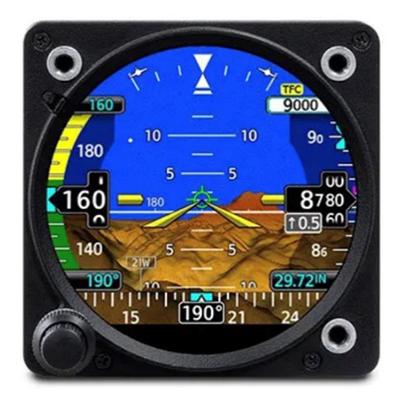
Garmin GI-275 showing enhanced display (altitude, airspeed) and synthetic vision
When flying the Bonanza with the two Garmin 275s, we noticed that we could not find the GPS/VLOC soft key anywhere on Garmin 750 Navigator – and it did not auto-switch during an ILS or LOC approach. Totally frustrated on the conclusion of our Saturday afternoon flight at the Norfolk BPT clinic, I vowed to research the issue and fly with this pilot again on Sunday morning. After talking with several other pilots at the clinic, we finally discovered that the soft key was buried under several menus on one of the GI 275s.
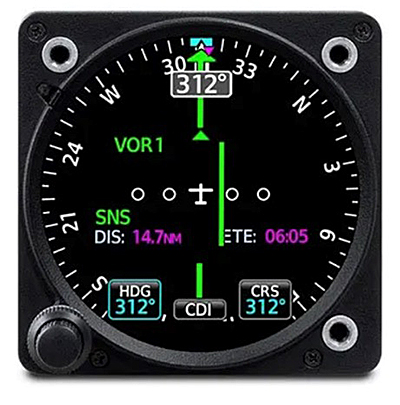
Garmin GI-275 in HSI mode showing heading course and course deviation indicator
We went flying again on Sunday morning and continued to build our knowledge of this avionics configuration. Many items were quite different from a G-500 TXI install that I previously mentioned. On the approach and missed approach, I found the sequence resembling the Garmin 480 that is installed in my Bonanza: the navigator auto-sequenced to the missed approach if you did not land. The servos did not disconnect, so the pilot needed to add power for the missed approach.
The missed approach at the airport where we were practicing had a rather complex missed approach procedure. There was a climb to a predetermined altitude followed by a turn to intercept a radial off a VOR and track to the missed approach point and hold. With very little setup for the missed approach by the pilot, the GI-275 and autopilot executed the procedure perfectly with altitudes and fixes recognized by the air data computer and GPS.
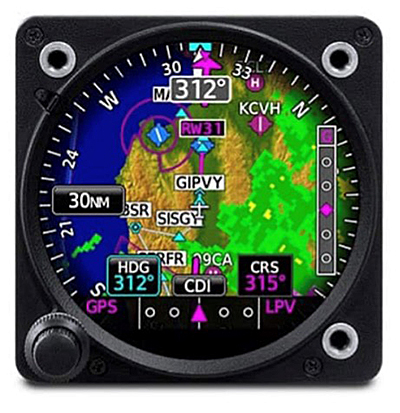
Garmin GI-275 in HSI mode displaying Course Deviation Indicator Glide Slope and Map
There is much to be said about how different combinations of the same manufacturers’ equipment work. Garmin offers flight envelope protection on its GFC-500 autopilot that worked in the GI-275 airplane but not in the G-500 TXI airplane. This “protection” prevents the airplane from doing stalls and unusual attitudes (over pitch or steep banks).
With the very limited time I had available, I was pleased to learn all the features of the Garmin GI-275. I was very impressed with the units, especially when paired with the Garmin GFC-500 autopilot. I had a conversation with the pilot I flew with a few days later, and he reported finding another menu to change from GPS to VLOC on the GI-275 as well as some other features new to him.
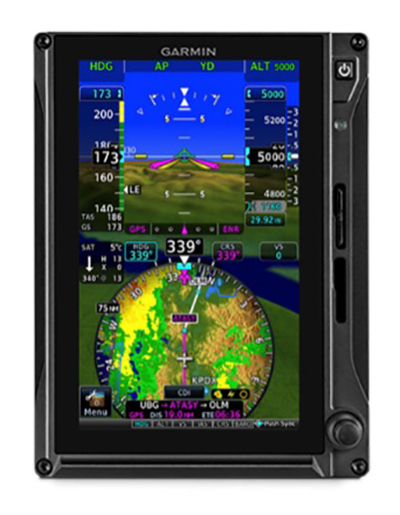
Garmin G-500 TXI display
Get well trained on your aircraft and avionics from a knowledgeable instructor. Remember, there are major differences in installs and firmware versions that may cause you to get into trouble easily. Don’t fly in IMC weather after maintenance or any equipment update or firmware changes.
See you at a BPT flight clinic near you soon!
Michael J. “Mick” Kaufman



